AKA which BBK should you not get?
There are a lot of options for BBKs engineered for this platform. There are also a few options that simply fit for this platform. You probably shouldn’t get any of the latter and we’ll go into why.
Preface and Audience
I’m not a brake engineer. You can get any of these options to work for your car, your mods, your driving style, your goals, etc. The intent of this article is to provide more information to the average person considering different BBK options for the car, with what works simply and easily, and allow them to compare and make a more educated choice on what option to go with. The intended audience is the average weekend track day guy shopping around for some improved braking ability.
Why Do We Want A BBK?
- To impress girls
- Additional thermal capacity on track; reduce temps, reduce/eliminate brake fade
- Hopefully improve braking distance
It’s obvious how the first two are accomplished. We throw more metal at the problem to dissipate heat and impress the ladies. What about the third? The tires actually do the stopping of the car; braking distances is mostly related to their sticky-ickyness. However, a BBK may improve the brake bias from factory settings either because a vendor found and tested a better front to rear ratio to distribute that breaking workload, and/or because of the characteristics of a car benefit from a much different one – for example, a car with a lot of rear aero finding more benefit than a stock car as the bias is pushed more towards the rear.
Exploring Brake Bias
Brake bias is simply how the work of braking is distributed between the front and rear of the car. Obviously the front is doing the most work – usually more weight is up there because of the engine, and in a braking situation, the weight is shifting to the front and loading those tires to do the brun of the work. Should they do 75% of that work though? 70%? 65%? What is best? Auto manufacturers do a lot of testing to determine their ultimate configuration. We trust BBK vendors to do the same for our more grueling track conditions. It seems more often than not that auto manufacturers lean towards the further side of front bias and that a typical engineered and tested BBK will either maintain that ratio or shift it more towards the rear, from modest to large amounts.
Creative people have also found ways to mount calipers from other vehicles to the 86; this includes STi calipers, Nissan Z32 calipers, and Cadillac ATS calipers; however these are simply big brakes that were made to fit, with no thought of looking at the bias whatsoever. Unfortunately this impresses girls and increases thermal capacity, however more often than not it shifts the brake bias forward quite a bit. This leads to the front tires doing too much and the rear too little and is very likely to increase stopping distances. While this can be corrected with a proportioning valve, there is work in installing and calibrating that and you can lose features like ABS as well. Given how cheap some of the options are for this platform, to me these options that need some correction seem more trouble than they are worth if you’re shopping around for an upgrade.
Here’s a great article on brake bias from StopTech. The long and short of it is that most engineered BBKs try to stick near OEM bias specifications, and move around it based upon individual car testing and need. It appears manufacturers in general err towards more front, and that modes shifts towards the rear help to use all four tires more effectively to distribute the braking load, resulting in better heat management and potentially better braking distances. Large shifts rearward should also likely be associated with additional aero load, such as functional rear wings.
The Results Of Too Much Bias
Well you should already know from reading the above that you don’t want a lot more front bias than stock – you probably don’t want any more than stock whatsoever. A picture is worth a thousand words though… Here’s two guys in two 86s, both with the front Wilwood 6R BBK installed. Pics are taken at the same track day that started out a little wet. Both have the same pad compound PolyMatrix B.

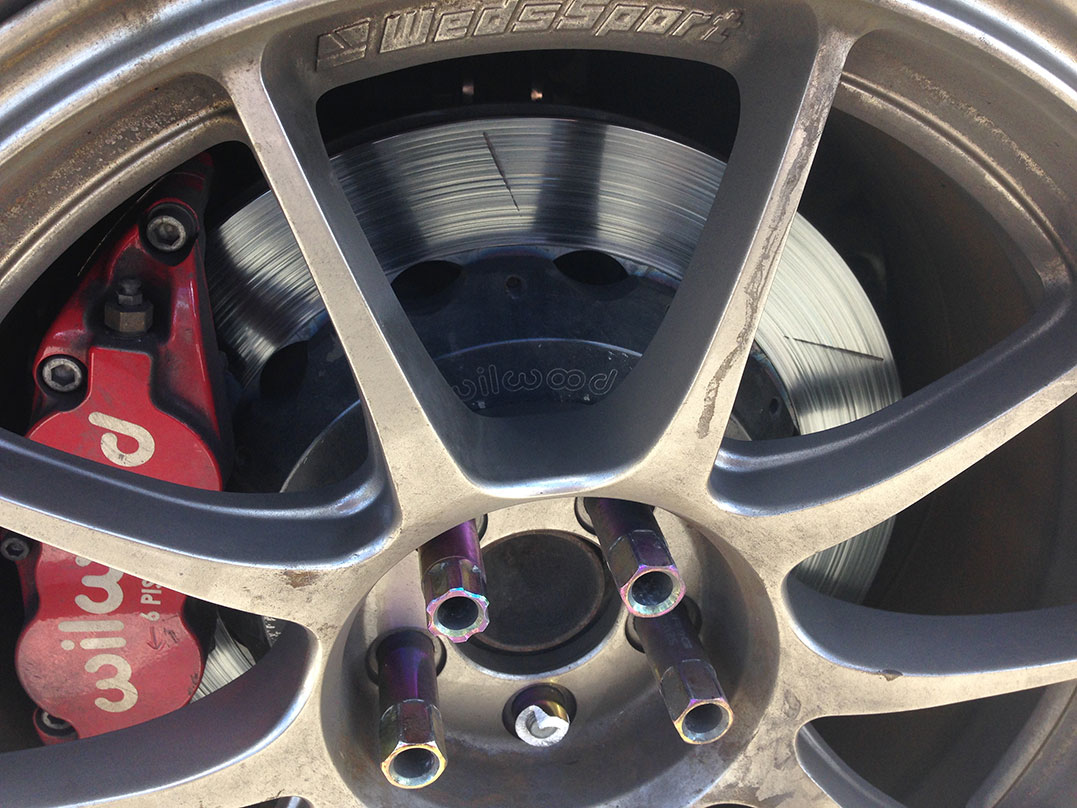
The second car’s friction rings were just recently replaced – after only being on the car for a year (daily driver) and only having been to 2 track days. What’s the real major difference here? The first car also has the Wilwood 4R kit in the rear – the latter has OEM brakes. It has a rather aggressive Carbotech XP10 pad in the rear even as well – however the front kit alone has a lot of front bias. It feels like Wilwood didn’t really intend for you to run just their front kit.
The Results Proper Bias
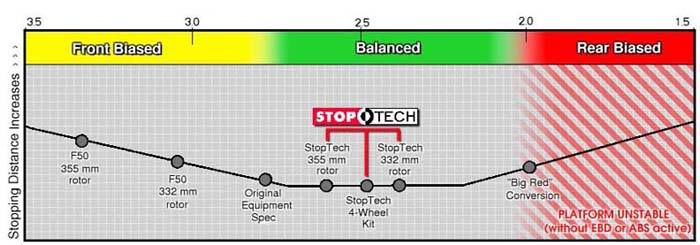
The chart above shows stopping distance vs. F:R ratio for a 2001 S4. Even small changes in bias meaningfully move the front to rear ratio across the x-axis resulting in performance changes along the y. Here we again see going more towards the front past the OEM spec on this car is not the optimal place to be.
Summing up a MotoIQ article done on upgrading a WRX with a StopTech kit, we see the following improvements vs. stock in braking to 0 from 60, 80, and 100 mph.

Brake Bias Calculations and Assumptions
Some assumptions and constants – the real measurement of importance for the rotor is the effective diameter, which is the measurement out to the center of the pistons. I don’t have that for most of these, so will be simply using the outer diameter of the rotor in its entirety. The radial height of the pads on these kits may also vary but I will simply be using the default value. I think it is a fair assumption to say these values have a ± 20% margin of error. However all numbers are calculated the same, which is not enough for us to design a kit around, but enough for us to do a rough comparison between the kits. Numbers run through the TCE Performance Brake Bias Calculator.
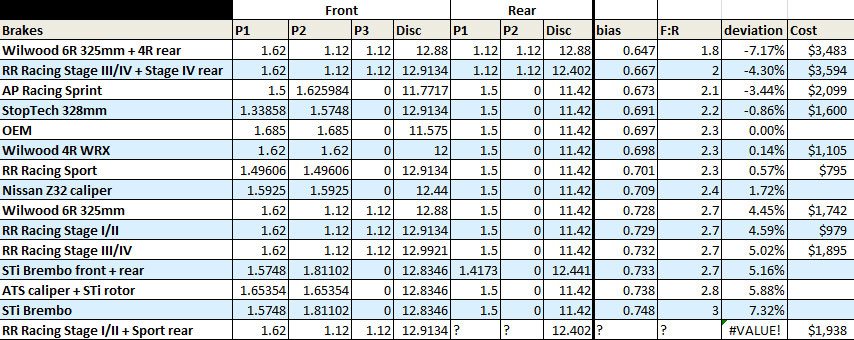

I also found an FT86 post where Essex ran their own kit and RRs with information they had at the time. I’ll note that they and I have very different results in regards to the Sports kit alone for the front and wonder if one of us had incorrect piston sizes.
| Brakes | Bias | F:R | Deviation |
|---|---|---|---|
| Essex Sprint | 66.3 | 1.97 | -1.19% |
| OEM | 67.1 | 2.04 | 0% |
| Essex Endurance | 68.5 | 2.17 | 2.09% |
| RR Stage I/II | 69.4 | 2.27 | 3.43% |
| RR Stage III/IV | 69.6 | 2.27 | 3.73% |
| RR Sport | 72.9 | 2.69 | 8.64% |
I’m not sure what inputs nor what calculator/options they used for these numbers, it’s certainly possible they were able to get less of a margin of error if they took into account things like pad radial height and effective rotor diameter, which I did not. We still achieve similar results in that we see the Sprint kit has moves bias rearward vs. OEM while doing front only RR (and by proxy, Wilwood) moves it forward, and a decent amount.
UPDATE: per user Lynxis the Sport kit is 1.615″ per piston. This would put bias at 0.732 or the exact same as the RR Stage III/IV.
Manipulating Brake Bias
I would try to pick a kit with your known intent in mind. Maybe you already have one of these kits and want to play around with your bias. I don’t know how difficult it is to install or calibrate a brake proportioning valve, and you may lose some things in the process (ABS?) Another option is manipulating your pad friction, of course while still keeping in your expected operating temperatures. RR Racing for example, recommends a higher friction compound pad in the rear when running the front kit. You can play around with the friction calculator above to try and find a pad combination that meets friction and operating temperature goals to try and shift your bias around. I am under the impression that larger amounts of bias moved rearward are appropriate for setups trying to get more braking work done back there, for cars set up with aero options like a large wing; staggered configurations with beefier tires in the rear seem like they may benefit as well.
Thoughts On Kits
There are a ton of options on this platform, and they all arguably have various pros and cons. I can’t run 17×9 RPF1s with my StopTech calipers for example, however the Wilwood 6R fits under them just fine. Togue Factory’s brake duct kit was designed to work with those calipers too – and does not with mine. If you don’t have a kit yet, I would seek out one that fits your needs, and would try to do minimal change to the bias or go for something that is moving it back. If you’ve already got one of these other kits, maybe this article will help you to find an improved bias point for optimal braking. Comments on some of these options below.
Looks And Street Driving – Wilwood 4R WRX – $1105

On the budget side of the scale, I simply would not do any of the caliper swaps from other cars if your car is currently in stock form as far as the brakes are concerned. They all have very significant shifts forward in brake bias. The Wilwood 4R kit actually made for the WRX has a very modest change in comparison. The rotors are surprisingly thin though – 20.5mm vs. OEM 24mm. I wouldn’t use these on track personally. You’re probably totally fine for autocross or going to Starbucks though. A slower track with a newer driver might be ok (100 mph straight, beginner group) but a faster track or more experienced driver should not consider these. Swift996 on ft86club had these and can attest to this as well from personal experience.
Wilwood vs. RR Racing
RR Racing produces kits with a lot of Wilwood calipers. One of the things they offer however is a lot more flexibility in rotor options as well as calipers. Stage I and III front kits use the same narrow caliper as the Wilwood 6R; however Stage II and IV use a regular sized one. All of these kits have the same piston configuration. The other difference is the rotors – Stage I and II use solid rotors. Stage III and IV use 2-piece floating rotors. The Wilwood 6R uses a 2-piece fixed rotor.

So what does all this mean? The narrow calipers will fit practically any wheel – the regular size ones may/will limit options and/or require spacers (which I personally avoid running.) The narrow calipers also have smaller pads, so they’ll have shorter lives – I would speculate the caliper itself dissipates less heat so the fluid may run warmer, although probably not in any amount that would be of concern.
2-piece rotors weigh considerably less and reduce a lot of unsprung weight at the wheel; this is less mass to rotate with accelerating the car which is always a plus, although it’s close to the center of rotation so is less meaningful than say a weight reduction in the wheels, particularly if that weight is lost around the outer rim or from the tires.
2-piece floating rotors means additionally that the lightweight aluminium hat is not screwed into the rotors but uses a bolt and oblong hole to allow much more free expansion between the hat and friction ring as the two metals experience two different temperatures, allowing them to expand and contract much more freely.
Both the 2-piece styles will keep heat away from the wheel bearing as well. I’m not sure if the floating costs more to replace – it does require new fastening hardware along with the rings, but if I compare Wilwood and RR list prices, the latter is cheaper. Perhaps it was a hook up, but the buddy that replaced his friction rings recently above got them for cheaper than the StopTech (floating) rings I just picked up, which are priced comparatively to the list prices of both Wilwood and RR kits. Is the floating part important for a regular HPDE car vs. a race car? Sure doesn’t hurt, although not sure how big of a decision maker it should be for you. All in all, the RR kits cost a little more – and it looks like that cost ends up going to a bigger rotor with a floating design.
StopTech 328mm – $1600

The prettier new install pic of my own kit is in the featured image this article started with. This kit uses 328×28 mm floating rotors and the 4-piston ST40 caliper. You can see some Tempil paint on the rotor above, where I applied some before a track day to see what kind of temperatures I was hitting. In intermediate doing some hopefully decent driving, my temps are looking pretty good both per this temperature sensitive paint and per Alcon temperature sensitive stickers on the calipers. I’m between 750-1000 F on my rotors – a proxy for pads, and 370-410 F on my calipers – a good proxy for fluid. These are well within operating specs for both my pads and my brake fluid. The bias moves a little towards the rear from OEM in my calculations above.
CSG Brembo GT System – $1835
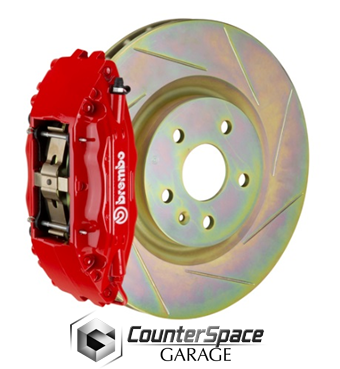
I don’t have piston sizes for this kit and this listing is a newer kit released since the initial version of this article. That being said I have faith in CSG in putting out a package that does not tweak the bias in negative ways. This is CSG’s take on a BBK that sees both track duty and daily driving as it includes dust boots. The Brembos are available in several colors and they are sitting atop thick 1-piece 326×30 rotors.
AP Racing/Essex Sprint – $2,100 (no pads)
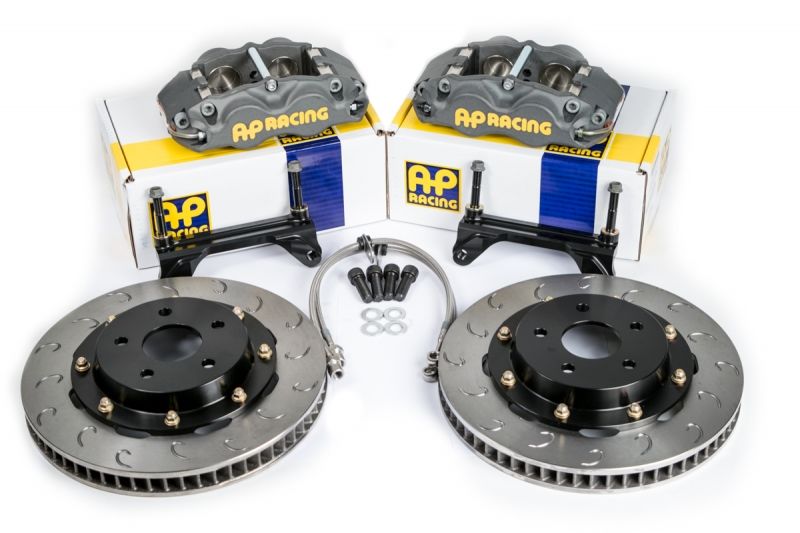
The Sprint kit looks really well designed and well thought out. Unlike other kits, it does not come with any pads. It looks like the 2-piece rotors are fixed, but floating are available on the endurance version of the kit. The friction rings of the fixed sprint kit rotors are a really great price. This kit comes with some nice anti-knockback features as well. It pushes the bias to the rear, and as we can see from their information above, the Endurance kit pushes the bias a little more forward. Both of these kits look like great options, although the more common one I see from HPDE guys is the Sprint. A local Spec86 owned by Stefan is running the Endurance kit.
Conclusion – Other Considerations and Other Kits
In general I would limit installing any kits to those above, I think they are the best options to consider of the bunch. I think the vast majority of track people looking to upgrade their OEM setup would be very happy with just installing the front StopTech, CSG, or AP/Essex Sprint kits. I would not be looking to STi or ATS calipers that simply fit, even for just a street car – they jack up the bias a lot, and the budget options listed above still get the job done and with far less of a change in that department. Another thing to consider here is that the StopTech has dust boots – the Sprint and Wilwood kits do not (maybe the RR Sport does?) – so if these calipers are kept on a daily driven car year round, they lose the street protection in dirty/dusty/winter situations that the StopTech has with these boots. Most of the rubber on my StopTechs is actually doing quite well in this department, just one side and one caliper in particularly looks like it needs to be replaced.
Note all the kits that look like they have the most thought out engineering in them move bias more towards the rear, as we might expect from StopTech’s article and charts as well. Street or track, I would avoid any kits and pad choices that look like they are going to shift bias a lot more to the front on a street car, or at all on a track car. I hope this article helps those shopping for a kit make a better educated choice among the many options available on this platform.


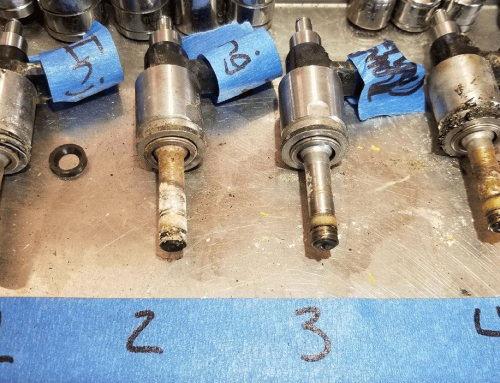


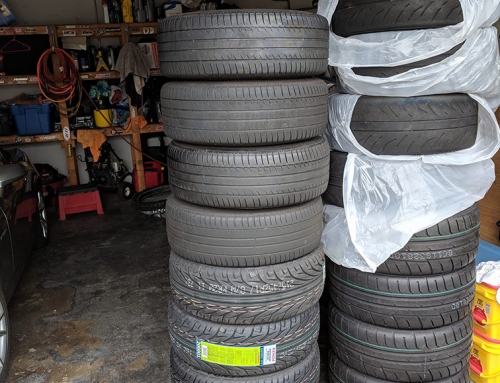

looks like the csg kit piston size is 36 and 40 mm. be interesting to see how they stack up against the rest
what’s the rotor size ?
For the data for the stoptechs, where the rear brakes also upgraded? Or was it only the fronts?
to which data are you referring? the bias calculation is fronts only.
Does this include the brembo kit that Subaru introduced to the ts models?
no
Come back here once in a while when I need to explain to someone WHY this matters.
A couple of notes:
– you calculated the WRX STi front + rears with 2005 rear Brembos, which have 2 36mm pistons. Newer 2008+ Brembos have 40mm pistons, which are much better bias-wise; would be nice to add that.
– RR Racing Sport kit (now?) uses the same 326x30mm rotor (ugh.. 12.83″ or 12,99″ if we consider the 330mm measure. They’re the same.) as the stage I/II/III/IV kit. And with that rotor the bias is *slightly* worse than the stage I/II/III/IV front-only kits, not better as pictured in the graph.
That’s all.